Hungarian cuisine

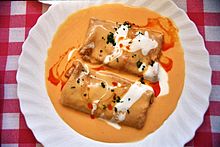


Hungarian or Magyar cuisine is the cuisine characteristic of the nation of Hungary and its primary ethnic group, the Magyars. Traditional Hungarian dishes are primarily based on meats, seasonal vegetables, fruits, fresh bread, dairy products and cheeses.
General features
Hungarians are especially passionate about their meat stews, casseroles, steaks, roasted pork, beef, poultry, lamb and game. The mixing of different varieties of meats is a traditional feature of Hungarian cuisine. Goulash, stuffed peppers, cabbage rolls, and Fatányéros (Hungarian mixed grill on a wooden platter)[1] are all dishes that can combine beef and pork, and sometimes mutton. Goulash is a stew with more gravy or a soup using meat with bones, paprika, caraway, vegetables (typically carrots and parsley root) and potatoes or various tiny dumplings or pasta simmered with the meat. Other famous Hungarian meat stews include paprikás, a paprika stew with meat simmered in thick creamy paprika gravy, and pörkölt, a Hungarian stew with boneless meat (usually beef or pork), onion, and sweet paprika powder, both served with nokedli (small dumplings). In old fashioned dishes, fruits such as plums and apricots are cooked with meat or in piquant sauces/stuffings for game, roasts and other cuts. Various kinds of noodles and dumplings, potatoes, and rice are commonly served as a side dish. Hungarian sausages (kolbász)[2] and winter salami are a major part of Hungarian cuisine.
Other characteristics of Hungarian cuisine are the soups, desserts, and pastries and stuffed crepes (palacsinta), with fierce rivalries between regional variations on the same dish (such as the Hungarian hot fish soup called Fisherman's Soup or halászlé, cooked differently on the banks of Hungary's two main rivers: the Danube and the Tisza), palacsinta (pancakes served flambéed in dark chocolate sauce filled with ground walnuts) and Dobos Cake (layered sponge cake, with chocolate buttercream filling and topped with a thin slice of caramel).
Two remarkable elements of Hungarian cuisine that are hardly noticed by locals, but usually elicit much enthusiasm from foreigners, are different forms of vegetable stews called főzelék[2] as well as cold fruit soups, such as cold sour cherry soup (Template:Lang-hu).
Hungarian cuisine uses a large variety of cheeses, but the most common are túró (a type of quark), cream cheeses, ewe-cheese (juhturó), Emmentaler, Edam and the Hungarian cheeses Trappista, Pálpusztai and Pannonia cheese.
Spices


Hungarian food is often spicy, due to the common use of hot paprika. Sweet (mild) paprika is also common. Additionally, the combination of paprika, lard and yellow onions is typical of Hungarian cuisine,[3] and the use of the thick sour cream called tejföl.
In addition to various kinds of paprika and onions (raw, sweated, seared, browned or caramelized), other common flavor components include: bay leaf, black peppercorn, caraway, coriander, cinnamon, dill, garlic, horseradish, lemon juice and peel, marjoram, mustard (prepared), oregano, parsley vinegar and vanilla. Less used spices are anise, basil, chervil, chives, cloves, juniper berries, lovage, mace, poppy seeds, rosemary, savory, tarragon, thyme and creeping thyme and white peppercorn.
History


Hungarian cuisine has influenced the history of the Magyar people. The importance of livestock and the nomadic lifestyle of the Magyar people is apparent in the prominence of meat in Hungarian food and may be reflected in traditional meat dishes cooked over the fire like goulash (in Hungarian "gulyás", lit. "herdsman's (meal)"),[3] pörkölt stew and the spicy fisherman's soup called halászlé are all traditionally cooked over the open fire in a bogrács (or cauldron). In the 15th century, King Matthias Corvinus[4][5] and his Neopolitan wife Beatrice, influenced by Renaissance culture, introduced new ingredients such as sweet chestnut and spices such as garlic, ginger, mace, saffron and nutmeg,[6] onion and the use of fruits in stuffings or cooked with meat.[7] Some of these spices such as ginger and saffron are no longer used in modern Hungarian cuisine.[8] At that time and later, considerable numbers of Saxons (a German ethnic group), Armenians, Italians, Jews and Serbs settled in the Hungarian basin and in Transylvania, also contributing with different new dishes. Elements of ancient Turkish cuisine were adopted during the Ottoman era, in the form of sweets (for example different nougats, such as white nougat called törökméz,[9] quince (birsalma) sweets, Turkish delight), Turkish coffee or rice dishes such as pilaf (in Transylvania), meat and vegetable dishes such as the eggplant, used in eggplant salads and appetizers, stuffed peppers and stuffed cabbage called töltött káposzta. Hungarian cuisine was influenced by Austrian cuisine under the Austro-Hungarian Empire; dishes and methods of food preparation have often been borrowed from Austrian cuisine, and vice versa. Some cakes and sweets in Hungary show a strong German-Austrian influence. All told, modern Hungarian cuisine is a synthesis of ancient Asiatic components mixed with Germanic, Italian, and Slavic elements. The food of Hungary can be considered a melting pot of the continent, with a culinary base formed from its own, original Magyar cuisine.
Hungarian meals


In Hungary, people usually have a large breakfast. Hungarian breakfast generally is an open sandwich with fresh bread or a toast, butter, cheese or different cream cheeses, túró cheese or körözött (Liptauer cheese spread), cold cuts such as ham, véres hurka (similar to black pudding), liver pâté (called májkrém or kenőmájas), bacon, salami, beef tongue, mortadella, disznósajt (head cheese), sausages such as kabanos, beerwurst or different Hungarian sausages or kolbász.[10] Even eggs, (fried, scrambled or boiled), French toast called bundáskenyér and vegetables (including peppers, bell peppers, tomatoes, radish, scallion and cucumber) are part of the Hungarian breakfast. Sometimes breakfast is a cup of milk, tea or coffee with pastries, a bun, a kifli or a strudel[3] with jam or honey, or cereal, such as muesli and perhaps fruit. Children can have rice pudding (tejberizs) or Semolina Cream (tejbegríz) for breakfast topped with cocoa powder and sugar or with fruit syrup. Hot drinks are preferred for breakfast.
Villásreggeli (literally breakfast with fork) is a more luxurious big breakfast given on special occasions or holidays. Often guests are invited. Deviled eggs, cold steak, cold salads, salmon-omelet, pancakes, a spicy cheese spread made with sheep milk cheese called körözött, caviar, foie gras, fruit salads, compote, fruit yogurts, fruit juices, champagne and pastries, cakes and cookies may be served.
Lunch is the major meal of the day, usually with several courses. Cold or hot appetizers[11] may be served sometimes (for example fish, egg or liver), then soup. Soup is followed by a main dish. The main dish is a dish including meat and salad, which precedes the dessert. Fruit may follow. In Hungary, pancakes are served as a main dish, not for breakfast. Salad is always served with meat dishes, made of lettuce with tomatoes, cucumbers and onions[11] or a simple thin sliced cucumber salad in vinaigrette. Salads such as Salade Olivier or potato salad are made of boiled potatoes,[2] vegetables, hard-boiled eggs, mushrooms, fried or boiled meat or fish, in vinaigrette, aspic or mayonnaise. These salads are eaten as appetizers or even as a main course.
Some people and children eat a light meal in the afternoon, called uzsonna, usually an open sandwich, pastry, slice of cake or fruit. Dinner is a far less significant meal than lunch. It may be similar to breakfast, usually an open sandwich, yogurt or virsli (hot dog sausage) with a bun, more seldom a cake, pancakes (palacsinta), and it consists of only one course.
Special occasions

For Christmas, Hungarians have a fish soup called halászlé. Other dishes may be served, such as roast goose, roast turkey or roast duck,[12] cabbage rolls (töltött káposzta). Pastry roll filled with walnut or poppy seed called (bejgli) is a usual Christmas food, and candies and sweets used to decorate the Christmas tree, such as szaloncukor are eaten during all Christmas, when everybody picks them and eats them directly from the tree. On New Year's Eve (Szilveszter), Hungarians traditionally celebrate with virsli (Vienna sausage, and lentil soup. On New Year's Day, it is common to eat either lentil soup or korhelyleves, a meaty sauerkraut soup said to cure hangovers.[13] Easter (Húsvét) meals have few specialties, though some Hungarians (especially in Szabolcs County) make a special sweet yellow cheese, Sárga túró, made with quark (túró) and eggs.[14]
Typical Hungarian dishes




Soups
- Gulyásleves (goulash soup; it is possible to cook gulyás like a stew as well, for example Székelygulyás)
- Halászlé (a famous hot and spicy fish soup with hot paprika)
- Húsleves (clear chicken (or veal meat) soup with soup vegetables and thin soup pasta called csipetke)
- Hideg meggyleves (chilled sour-cherry soup)
- Jókai bableves (a bean soup named after the author Jókai Mór)
- Vadgombaleves (wild mushroom soup)
- Borleves (wine soup)
- Palócleves (named after Mikszáth Kálmán's nickname[15])
- Köménymagleves (caraway seed soup)
- Zöldségleves (vegetable soup, made for example of peas, carrot, parsley)
- Krumplileves (potato soup)
- Tojásleves or Rántott leves (soup made with scrambled eggs and caraway seeds)
- Pacal (tripe soup)
Main courses
- Chicken paprikash called Csirkepaprikás (a stew with a lot of sweet paprika, cream or sour cream called tejföl)
- Császármorzsa (sweet crepe crumbs)
- Főzelék (thick vegetable stew)
- Székelygulyás (Goulash stew; can be made from three kinds of meat and sauerkraut)
- Lecsó (mixed vegetable stew, made of tomato and paprika, somewhat similar to ratatouille)[16]
- Fasírt
- Stefánia szelet or Stefania slices (Hungarian meatloaf with hard boiled eggs in the middle. Makes decorative white and yellow rings in the middle of the slices)
- Pecsenye (thin pork steak served with cabbage or the dish fatányéros, a Hungarian mixed grill on wooden platter)[17]
- Pörkölt (meat stew) - similar to ragù
- Palacsinta (stuffed Hungarian crepes, usually filled with jam. Other fillings are sweet quark cheese with raisins or meat)
- Gundel palacsinta (Gundel crepe, stuffed with walnuts and served in chocolate sauce, often flambéed)
- Hortobágyi palacsinta (savoury crepe filled with veal stew)
- Rakott palacsinta (layered Hungarian crepes with sweet cottage cheese, raisins, jam and walnuts)
- Paprikás krumpli (paprika-based stew with spicy sausage and potatoes)
- Rántott sajt, (flat cheese croquette, cheese rolled in breadcrumbs and, deep fried)
- Rakott Krumpli (potato casserole, see recipe on Wikibooks Cookbook)
- Rakott káposzta (layered cabbage with Pörkölt and rice and sour cream- recipe from Transylvania/Erdely)
- Sólet (Jewish-Hungarian bean stew)
- Szilvásgombóc and nudli (sweet plum dumplings and small noodles, rolled in sweet fried butter breadcrumbs or streusel)
- Szűz tekercsek (literally "Virgin roulade" filled with minced meat)
- Töltött káposzta (stuffed cabbage)
- Töltött paprika (Stuffed peppers - ground meat, rice and spices are used for the filling)
- Töltött tojás or kaszinótojás (Literally stuffed egg or "casino egg" - Deviled egg served cold in mayonnaise or warm, baked in the oven with sour cream)
- Túrógombóc (Hungarian sweet quark cheese dumpling)
- Túrós csusza (noodles with quark cheese called túró - served savoury with bacon or sweet)
- Vadas marha (Beef with a sauce made of carrot and other root vegetables, usually served with bread dumplings)
- Wiener schnitzel (called Bécsi szelet, more commonly Rántott hús)
Sausage and cold cuts
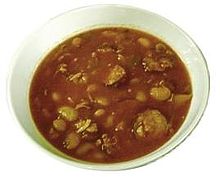
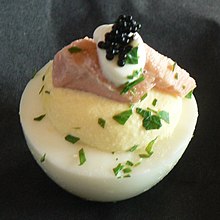


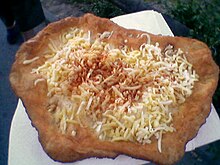
- Hurka (sausage, two types: liver sausage called májas hurka, made of pork liver, meat and rice and black sausage called véres hurka, which is equivalent to the black pudding)
- Téliszalámi (or Winter salami, salami made of spiced meat, cold smoked, and dry ripened, the most famous brand made by Pick Szeged)
- Herz Szalámi
- Csabai szalámi and kolbász (spicy salami and smoked sausage, made in the town of Békéscsaba)
- Gyulai kolbász (spicy sausage, made in the town of Gyula)
- Debreceni kolbász (Debrecener sausage)
- Disznósajt (pig cheese, meat jelly, meat slices in aspic with additional gelatin)
- Szalonna (Hungarian bacon, fatback, back bacon rind, has more fat than usual breakfast bacon)
- Virsli (a Frankfurter-like long and thin sausage, consumed boiled with bread and mustard)
- Lókolbász (Horse sausage)
Sweets and cakes
- Dobos Cake (sponge cake layered with chocolate paste and glazed with caramel and nuts)
- Linzer torta (a tart with crisscross design of pastry strips on top)
- Rigó Jancsi (Cube-shaped sponge cake with dark chocolate glaze)
- Gesztenyepüré (cooked and mashed sweet chestnuts with sugar and rum, topped with whipped cream)
- Bejgli[2] (cake roll eaten at Christmas and Easter)
- Kürtőskalács Stove cake or Chimney cake, cooked over an open fire — a Transylvanian specialty, famous as Hungary's oldest pastry
- Csöröge (crispy, light Hungarian Angel Wing fry cookies,[2] a twisted thin fried cookie made of yeast dough, dusted with powdered sugar)
- Vaníliás kifli (vanilla croissant, small, crescent shaped biscuits)
- Piskóta (thin, light, sweet delicate, crispy cookie)
- Rétes (strudel)
- Képviselő Fánk (Hungarian Cream Puff made from choux paste and filled with vanilla cream. Literal Translation - 'Ambassador Doughnut')
- Kuglóf (Kuglóf cake, a traditional Austro-Hungarian coffee party cake)
- Lekváros Bukta or Bukta (a baked dessert filled with jam, túró or ground walnuts)
- Lekváros tekercs (Rolled up soft sponge cake filled with jam)
- Lekvár (Thick Hungarian jam)
- Birsalma sajt[18] (Quince cheese, or quince jelly made of quince fruits)
- Törökméz[9] (a sweet sticky white nougat paste cooked with sugar, eggwhites, honey, bits of walnuts, spread between two wafer sheets)
- Halva (a Transylvanian sweet confection, made with sunflower seeds, of Turkish origin)
- Madártej (Floating island, a dessert made of milk custard with eggwhite dumplings floating on top)
- Túró Rudi (sweet quark cheese - called túró - filled chocolate bar)
- Szaloncukor (flavoured candies that hang on the Christmas tree, eaten at Christmas)
- Arany galuska (dumplings, or dough balls rolled in butter, sugar, and nuts and packed together to make a pull-apart cake, with vanilla custard)
- Vargabéles (Hungarian strudel or Noodle Pie)
- hu (Somló-style Sponge Cake)
- Palacsinta (crêpe-like variety of pancake)
- hu[19] (A Hungarian-Jewish dessert, a cake with 4 different fillings, poppyseed, walnut, apple and plum jam)
Others
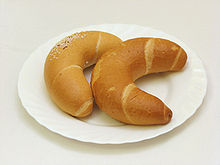
- Lángos (fried bread dough)
- Pogácsa (a type of bun, round puffed pastry with bacon, traditionally cooked on the fire)
- Zsemle (round small breads, eaten cut in half, with butter, cold cuts or jam, often for breakfast)
- Fánk or Bismarck Doughnuts
- Kifli (crescent-shaped pastry, see picture)
- Perec (Pretzel, salty crispy pasty)
- Májgaluska (small liver dumplings used in different soups, for example liverball soup)
- Grízgaluska (Hungarian boiled semolina dumplings used in soup)
- Tarhonya (a kind of large Hungarian "couscous", big pasta grain, served as a side dish)
- Rizi-bizi (Hungarian risotto, white rice mixed with green peas, served as a side dish)
- Vinetta or padlizsán krém (Transylvanian mashed eggplant salad made of grilled, peeled and finely chopped eggplants)
- Körözött or Liptai túró (cheese spread with ground sweet paprika and onions)
- Libamájpástétom (Hungarian delicacy: foie gras - goose liver pâté)
- Bundás kenyér (literally, "coated bread" or "bread with a fur", French toast or Gypsy toast or bread fritter, a breakfast food or eaten with spinach)
- Bread (Hungarian bread - kenyér - is baked fresh every morning in the bakeries. The traditional form called cipó is big, round and with a hard thick crust. The other bread type is vekni: long loaves with crispy crust, thicker or thinner, like the baguette.)
Drinks

Hungarian wine dates back to at least Roman times, and that history reflects the country's position between the Slavs and the Germanic peoples. The best-known wines are the white dessert wine called Tokaji (after the North-Eastern region of Hungary, Tokaj) and the red wines from Villány (Southern part of Hungary). Famous is also the wine called Bull's Blood (Egri Bikavér), a dark, full-bodied red wine. Hungarian fruit wines, such as redcurrant wine, are mild and soft in taste and texture.
Though not as famous as the country's wines, Hungarian beer has a long history as well.
Hungary's most notable liquors are Unicum, a herbal bitters, and Pálinka, a range of fruit brandies (plum and pear are popular). Also notable are the 21 brands of Hungarian mineral waters (for example Apenta and Kékkúti).[20] Some of them have therapeutic value, such as Mira.
Traubi or Traubisoda, is a soft drink based on an Austrian license produced in Balatonvilágos since 1971.
See also
- Hungarian Festival
- Hungarian Food Safety Office
- List of Hungarian dishes
- List of restaurants in Hungary
- National symbols of Hungary
- Náncsi Néni (restaurant)
References
- ^ "Famous Hungarian recipes". Eng.grocceni.com. Retrieved 2014-03-12.
- ^ a b c d e June Meyers Authentic Hungarian Heirloom Recipes Cookbook
- ^ a b c Gundel's Hungarian Cookbook, Karoly Gundel.
- ^ A magyar konyha története
- ^ "Hotdog.magazin".
- ^ "Gourmandnet".
- ^ "Hungarian Cuisine, History, Gastronomy, Legend, Memoires, Recipes and Lore".
- ^ "health-family".
- ^ a b Törökméz
- ^ Gundel's Hungarian Cookbook, Karoly Gundel, page34
- ^ a b Gundel's Hungarian Cookbook, Karoly Gundel
- ^ Hungarian cuisine, József Venesz ISBN 963-13-0219-9: Corvina Press 1977
- ^ Korhelyleves, Chew.hu
- ^ Sárga túró (Yellow Cheese), Magyar News 2013-02-28
- ^ "Palócleves, amit nem is a palócok találtak ki". Origo. 2015-06-24. Retrieved 2015-06-25.
- ^ Gundel, Karoly (1992). Gundel's Hungarian cookbook. Budapest: Corvina. ISBN 963-13-3600-X. OCLC 32227400.page 100
- ^ Gundel, Karoly (1992). Gundel's Hungarian cookbook. Budapest: Corvina. ISBN 963-13-3600-X. OCLC 32227400.page 83
- ^ Quince-cheese
- ^ http://jewish.hu/view.php?cid=81_flodni_1000_kcals%20
- ^ "Mineral Waters of the World". Pmgeiser.ch. Retrieved 2014-03-12.
